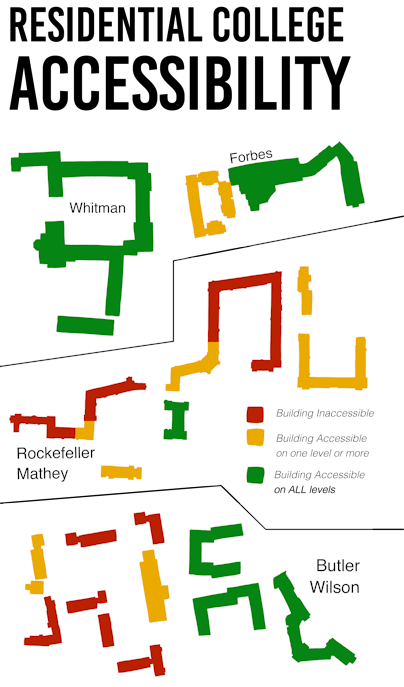How many of the buildings are wheelchair-accessible on Allegheny’s campus? Maybe half of them, but that’s only if the residence halls aren’t included. But we definitely aren’t the only campus with a lack of accessibility. Across the country, more than 25 colleges, such as Princeton, Yale, and MIT, have all been involved in lawsuits or various investigations due to their lack of accessibility. It’s been 3 decades since the Americans with Disabilities Act (ADA) was passed, which requires new constructions to meet certain accessibility standards, but the language is vague for pre-existing buildings, stating that “reasonable accommodations” must be made.
Well what exactly is “reasonable” and who gets to make that decision? For me, reasonable would be if students in wheelchairs could attend classes and get to and from their dorms (and I’d argue their friends dorms as well) without the physical barriers of a lack of elevators or ramps to enter buildings.
 |
| Varying wheelchair accessibility levels of buildings on Princeton's campus |
A lot of progress has been made in the last 25 years, but at several schools, barriers are still in place that prevent students in wheelchairs from attending that institution at all. In fact, the Christopher and Dana Reeve Foundation recommends that students visit schools prior to attending in order to determine if schools meet their needs. Then once at a school that’s “accommodating,” students in wheelchairs still face the burden of working with the disability services department to secure any accommodations that they may need, which doesn’t always go as smoothly as we’d hope.
At the University of Buffalo, students are speaking out about their experiences of a lack of access. Graduate student, Emily Tout, says that even her child’s size wheelchair doesn’t fit in many of the bathrooms. In a building where she had class frequently, Tout had to ask a friend to carry her from the hallway to the stall, to the sink, and then back to her wheelchair whenever she wanted to use the bathroom. Another student, Connor Gow, had to try to balance his laptop on his legs during class since there were no accessible tables. A third student, Zachary Dickman, missed class because his classroom lacked an access button, and no one knew that he was trying to get in.
The University of Buffalo recognizes that it isn’t 100% compliant with ADA guidelines, mostly due to the age of the buildings, but I’m not so sure that this is the only issue at play. Even at schools with more accessibility accommodations in place, students face issues of gaining access to resources such as elevators. At Columbia, Eun Oh went through all the necessary steps to gain elevator access to the elevator and skybridge that she needed to get to her class, but realized the day of class that she nor a disability services employee had access. By the time she was let in, she missed her entire class— she ended up dropping it.
Although the physical structure and age of several academic buildings poses a huge problem to accessibility, experiences like Oh’s where access could be granted, but isn’t, are not uncommon. When colleges have the ability to give access and don’t— whether it’s elevator access or neglect to shovel snow off of ramps to get into buildings— it sends the message that we don’t care about whether or not students in wheelchairs have access.
This needs to change. I know that renovations to old buildings to make them accessible aren’t always financially feasible but it is something that colleges should be actively working towards. Additionally, steps to ensure that students are given proper access to already-existing accommodations should be taken more seriously because it is definitely not "unreasonable" for students in wheelchairs to be able to access their classes.
No comments:
Post a Comment